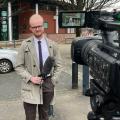
A 'DIGITAL twin' has been created of Warrington that is aimed at helping the town become more environmentally friendly.
The entire town has been mapped digitally in order to create a 3D model of 29 different areas of Warrington.
This 'digital twin' will help the council to identify energy, carbon, and cost-efficiency measures that can be implemented throughout the town to reduce buildings' energy wastage.

This project is intended to identify the data-informed pathways to net zero, being led by the charity Pure Leapfrog with input from Warrington Borough Council.
The council declared a climate emergency in 2019 and is working on a variety of initiatives to shape and guide its journey towards net-zero emissions.
Various data streams fed into the development of the digital twin and included details such as geo-located building geometry, building use and age, building characteristics and electric network infrastructures.
Information from each of the 29 areas was individually modelled in IES’s master planning and urban design tool, Intelligent Community Design (iCD).
This tool analyses and monitors how the community may evolve over time and tracks the environmental impact of any changes such as population growth, the installation of renewable energy systems and changes to the massing and form of buildings.
Warrington Borough Council cabinet member for sustainability and climate change, Cllr Janet Henshaw, said: “A shared central database and interconnected tools have allowed data and analysis to be easily shared between key stakeholders within this project, laying out some pathways for potential future decarbonisation.
“Using the model to full effect will allow the Council to see various possible optimisation scenarios and understand the potential return on investment for associated decarbonisation initiatives.”

Fergus Ross, ICL project manager at IES, said: “Working with Warrington Borough Council on the REWIRE North West project has shown how we can quantify energy-saving measures and support local councils in seeking to secure investment in decarbonisation initiatives.
"These models are easily replicable to any UK city and hold a huge amount of potential in bolstering the country’s progression towards net-zero, so we really hope to see more councils implementing this kind of technology."



Comments: Our rules
We want our comments to be a lively and valuable part of our community - a place where readers can debate and engage with the most important local issues. The ability to comment on our stories is a privilege, not a right, however, and that privilege may be withdrawn if it is abused or misused.
Please report any comments that break our rules.
Read the rules hereLast Updated:
Report this comment Cancel